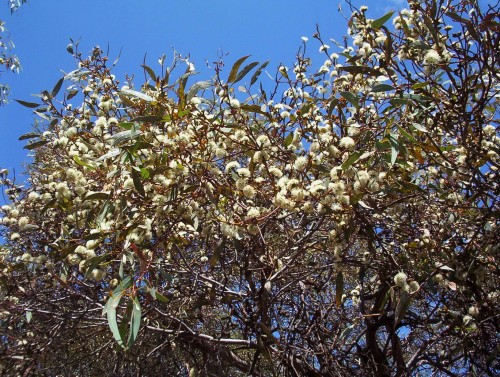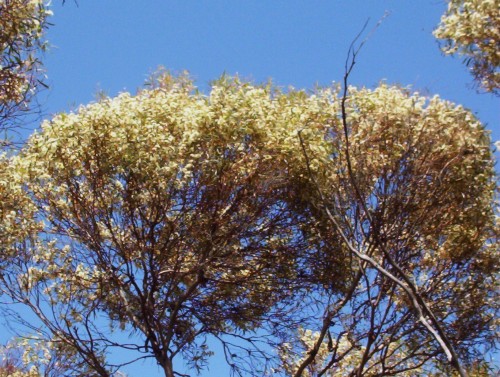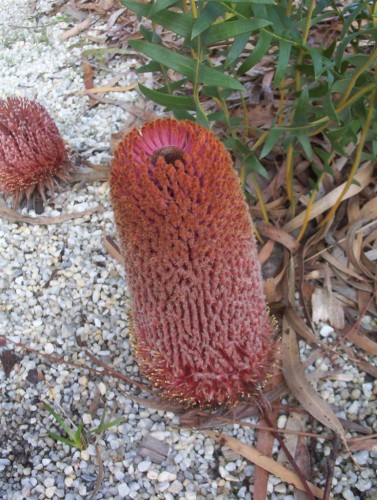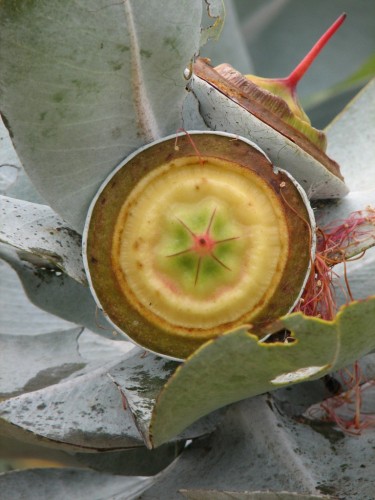More Plants for Dry Conditions
I was thinking about the list so far realizing that there are many plants which fit this category which I do not actually know apart from what I read in specialist books. There is great information available if it can be found. In most cases it is important to remember that these plants need to have good drainage. Raising the planting hole or the garden bed as little as 100mm (4″), will provide sufficient drainage.
More Plants for Dry Conditions prostrate to 1 metre high.
Hakea purpurea prostrate form
Hakea ‘Burrendong Beauty’
Hardenbergia violacea, purple, pink, white
Hardenbergia comptoniana
Chrysocephalum apiculatum
Chrysocephalum semipapposum
Hibbertia cunieformis
Hibbertia sericea
Homoranthus flavescens
Isopogon anethifolius
Isopogon formosus
Kennedia beckxiana
Kennedia macrophylla
Kennedia prostrata
Kennedia retrorsa
Leptospermum juniperinum variety horizontalis
Macrozamia communis
Melaleuca pauciflora
Melaleuca pulchella
Melaleuca scabra
Melaleuca thymifolia
Melaleuca violacea
Prostanthera calycina
Prostanthera magnifica
Ptilotus obovatus
Thryptomene saxicola ‘Paynes Hybrid’
Verticordia grandis
Verticordia nitens
Verticordia plumosa
Westringea ‘Jervis Gem’
Plants That Tolerate Dry Conditions
A list like this could have some surprising species. Drought tolerance is a subjective thing in a plant. It depends on the amount of natural rainfall, whether it fell in the usual time of the year for the area, whether the garden is mulched, what shade is available, protection from hot drying winds etc. It is easier to change the conditions in a garden than in a paddock. In general, if conditions have been average then these plants should manage 3-4 months of summer with little extra water. Of course if some water is available they will do better. One deep watering is far more beneficial than many light weekly waterings in any situation. Be aware that many Australian native species have a ‘quiet’ time during summer and manage on little water as a result. Excessive watering in this case is likely to kill the plants. It pays to know about the plants that are grown.
This list is intended for garden culture. These are some plants I know of. There will be many that can be added.
Some Plants that tolerate dry conditions prostrate to 1 metre tall.
Acacia brownii
Acacia lasiocarpa
Acacia mitchellii
Acacia pulchella
Astroloma humifusum
Astroloma pinifolium
Banksia petiolaris
Boronia caerulescens
Boronia filifolia
Boronia inornata
Calocephalus brownii
Calothamnus vallidus
Carpobrotus rossii
Carpobrotus modestos
Cheiranthera linearis
Dampiera linearis
Dampiera marifolia
Dampiera rosmarinifolius
Darwinia neildiana
Eremaea fimbriata
Eremaea violacea
Eremophila densifolia
Eremophila glabra forms
Eremophila glabra ‘Kalbarri Carpet’
Eremophila teretifolia
Eremophila veneta
Eriostemon pungens
Eriostemon verrucosus
Grevillea baxteri
Grevillea ‘Crosbie Morrison’
Grevillea juniperina (prostrate)
Grevillea nudiflora
Grevillea ‘Poorinda Royal Mantle’
Grevillea thelemanniana prostrate forms
Grevillea ‘Ellendale Pool’
Grevillea ‘Ellendale Lace’
Mallee in Flower
I was working in the Nursery this morning and could hear what I thought was the neighbour’s air conditioner. It was there in the background but I could not track the other noise that was there. When I looked up above my head I saw it. There were hundreds of bees in the canopy of the tree because it was smothered in flowers.
I love our local mallee trees. Against all odds they put on beautiful new new leaf growth and flower prolifically when everything else has ‘quietened down’ for the hot summers we have here. We seem to have three different species and they flower consecutively. If I was into bee keeping, it would be worth while having hives here for about three months. These are moderately fast growing plants suitable for limestone soils.
Banksia blechnifolia
This photo was taken at the entrance to Cranbourne Botanic Gardens. The soil is quite sandy and reflects the main need for all Banksias and that is very good drainage. This can be achieved by planting in a raised bed. I have read that the top of the planting hole only needs to be 4-6 inches (10-20cm) above the surrounding ground level to achieve the drainage required. The plant grows 2-4m wide and about 50cm high.
This is an adaptable drought hardy plant originating in Western Australia, north of Esperence. It will tolerate dappled shade through to full sun. It withstands light to moderate frosts.
Eucalyptus macrocarpa (Mottlecah)
This beautiful shrubby tree has been the subject of some comments on an earlier article that I wrote. I responded to one reader who asked about the life span and hardiness of the tree…
“I can tell you from experience that Eucalyptus macrocarpa is a long lived plant. One that I know, at the end of a school playground, continues even now after 25+ years of being trampled, swung in, climbed through, footballs thrown in etc. Another near where I live is about 23 years old. These are mallee plants ie, shoot from the base when broken or cut or burnt, and have multiple stems. They need good drainage and airflow around them otherwise they tend to suffer from sooty mould. Eucalyptus macrocarpa is well worth trying for the flower display. It would make good large pot plants if you cannot give it the conditions that is needed.â€
Another reader’s comment would interest Australian plant growers.
From Ron…”I have grown Eucalyptus macrocarpa in my garden for more than 20 years. They seem to thrive on the hot/dry summers we have here in Escondido, CA. (We only average about 12 inches (300mm) of rainfall a year and recently we haven’t even seen that. Our rainy season in in the fall and winter.)
I rarely ever water the plants and they are very adapted to drought once established. My trees (very shrubby, multibranched, 12ft.(4metres) high) are absolutely beautiful. Although the oldest of my 3 trees is a little more than 20 years old, I know of several in San Diego (about 20 minutes from my house) that are more than 35 years old and I suspect thay live a lot longer than that.
So they have a very long lifespan.”
The conditions sound like mine here except that we are experiencing drought at the moment and have no subsoil moisture. Even the native plants are struggling. (The photo above shows some sooty mould on the leaves.)
More on this plant here.



